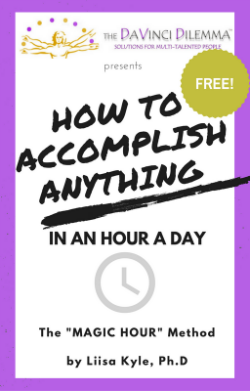
By Joakim Berndes [CC BY-SA 4.0 (https://creativecommons.org/licenses/by-sa/4.0)], from Wikimedia Commons
You’ll thank yourself, too. By taking short breaks
* you’ll keep your energy higher and avoid fatigue
* you’ll avoid procrastination
* you’ll maintain clearer focus and avoid distractions more easily
* you’ll probably experience some ‘aha’ ideas when you step away from your project momentarily
* you’ll get more done
* you’ll find yourself less stressed and healthier
So what’s the catch? There must be a catch. Actually there are two.
Catch # 1:
For these mini-breaks to have the desired effect, you need to do them every hour of focused activity and you need to restrict them to 5 – 10 minutes maximum. You’ll need to set a timer and otherwise manage yourself to maintain this new rhythm: 50 – 55 minutes of work followed by 5 – 10 minutes break. Repeat. This means that you really must pause work when the timer goes off – even if things are really humming for you. And you really must end your break when the timer goes off or else you’re just defeating the purpose of the break you’re taking.
Catch # 2:
There are ‘good breaks’ and ‘not-so-good breaks’. ‘Good breaks’ include things like stretching, meditating, mindful eating, physical activity (yoga, jumping jacks, crunches or walking around the block), petting the dog, listening to a great song or simply lying down and resting your brain briefly. Things that are pleasant, peaceful and a change from your major activity are ideal – and this will be unique to you and the task at hand. Writers need to take a break from sitting at the keyboard whereas dancers need to rest their bodies. Musicians may need some quiet time whereas actors may need to do the hokey-pokey.
‘Not-so-good breaks’ include things like shoveling unhealthy food into your gullet while maniacally surfing the ‘net while trimming your toenails. Any multi-tasking, any stressful activity (like calling the cable company) or things difficult to stop after just five minutes (e.g. napping or computer Scrabble or chatting with a friend) should be avoided. Again, this is highly individualized.
Activity #1: Prepare for your Mini-Breaks
You know what is a ‘good break’ for you. Make a list of ten pleasant, healthy things you could do as a 5 – 10 minute treat between blocks of focused activity.
Make a list of ten things that would be ‘not so good breaks’ for you – things that are stressful or unhealthy or addictive i.e. likely to spill over into the next hour.
Activity #2: Try the Mini-Break Method
1. Set a timer for 50 – 55 minutes.
2. Do your focused activity. Avoid distractions. (If you think of something that needs doing, write yourself a quick note and get back to what you were doing).
3. When your timer goes off, refer to your list of ‘Good Breaks’. Pick one, set your timer for 5 – 10 minutes and do it.
4. When your timer goes off, repeat steps 1 – 3.
It might take a bit of adjustment to find the right combination of timing and activities, but once you find what works for you, keep track of your progress and see if you experience the same results that so many of us have, using this method.
We’d like to hear about your experience with Mini-Breaks: what ‘good breaks’ work well for you? What doesn’t? What benefits have you noticed?
*****
 Want more tips and techniques on getting things done? Check out my book YOU CAN GET IT DONE: Choose What to do, Plan, Start, Stay on Track, Overcome Obstacles, and Finish
Want more tips and techniques on getting things done? Check out my book YOU CAN GET IT DONE: Choose What to do, Plan, Start, Stay on Track, Overcome Obstacles, and Finish
Available here in paperback or eBook format: http://bit.ly/YouCanGetItDone
*****
If you’d like to share or publish this article, you may, if you include the author’s name, a link to this original post and the following text blurb:
Are you struggling with too many talents, skills, ideas? You may have The Da Vinci Dilemma™! Find tools, fun quizzes, coaching, inspiration and solutions for multi-talented people at http://www.davincidilemma.com/.



